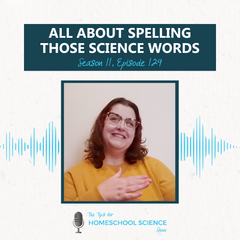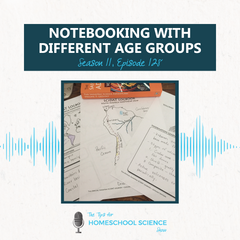FREE Shipping on all our products! (Please Note: Orders may experience a delay of a week or more in shipping due to the high volume of orders at this time of year.)
FREE Shipping on all our products! (Please Note: Orders may experience a delay of a week or more in shipping due to the high volume of orders at this time of year.)
How to Keep a Written Record of Hands-on Science for All Ages {Episode 93}
January 25, 2021 2 min read

So you have been doing hands-on science activities and your kiddos are having a blast! And you know that these will become a part of your weekly routine, but how do you keep a record of the science they are learning is behind those activities?
Simple – you have them write it up.
And in today’s podcast, we are going to breakdown what this should look like through the ages. Welcome to season 7 of the Tips for Homeschool Science Show, where we are exploring the how-to’s of teaching science at home so that you will have building blocks you need for homeschool science.
I am Paige Hudson, your guide through this journey. Let’s dig in…
Listen to this episode
You can also listen to this podcast on iTunes, Stitcher, or Spotify.
Share the Tips
If you found these homeschool science tips to be helpful, would you please take a moment to rate it in the podcasting app you use to listen to the show? This would help me tremendously in getting the word out so that more earbuds are filled with science-teaching encouragement.
Episode 93 - How To: Keep a Written Record of Hands-on Science for All Ages
This audio is an expansion of a popular post from Elemental Science. See the original post here:
- How to record an experiment (You can also download free templates from this post.)
Timestamps
Here is what you'll find in this episode:
(0:45)
What season 7 of the Tips for Homeschool Science Show will look like.
- We'll be chatting about how-to's
- Some will be from popular posts and some will be brand-new content
- Let us know (support@elementalscience.com) if you have a how-to question you would like us to address
(2:11)
This episode to about how to keep a written record of your hands-on science activities.
- This will change with age
- It's one of the three keys to teaching science
- ALWAYS keep writing expectations at or below the student's level
(3:19)
If you have a preschooler, you will want to listen to this part!
- Keep it simple and sweet
- Just a picture and a sentence
(4:48)
If you have an elementary student, you will want to listen to this part!
- And, keep it simple
- Four sections - tools, methods, outcome, and insights.
- Begin to show what the scientific method is all about
(7:37)
If you have a middle school student, you will want to listen to this part!
- Reports will be after the scientific method
- Six sections, some can come from the program you use
- Include the title, hypothesis, materials, procedure, observations/results, and conclusions
(11:48)
If you have a high school student, you will want to listen to this part!
- Same as middle school, but with more detail
- Those going into science can add analysis and research as well
(13:04)
Get help for teaching science at home with our programs.

Also in {Podcast} The Tips for Homeschool Science Show
All About Spelling Those Science Words {Season 11, Episode 129}
March 25, 2024 7 min read

In this episode, we'll be interviewing Robin Williams from All About Spelling. Click "Read More" to listen is as we discuss tips and tricks for spelling all those science words!
How should you handle notebooking through the different ages? {Season 11, Episode 128}
March 18, 2024 3 min read

Writing in Science with a Well-Trained Mind (Interview) {Season 11, Episode 127}
March 11, 2024 16 min read

Click "Read More" to listen in as Susan Wise Bauer and Susanna Jarret join Paige to share tips and tools about the third key to teaching science!
Subscribe
Sign up to get the latest on sales, new releases and more …

